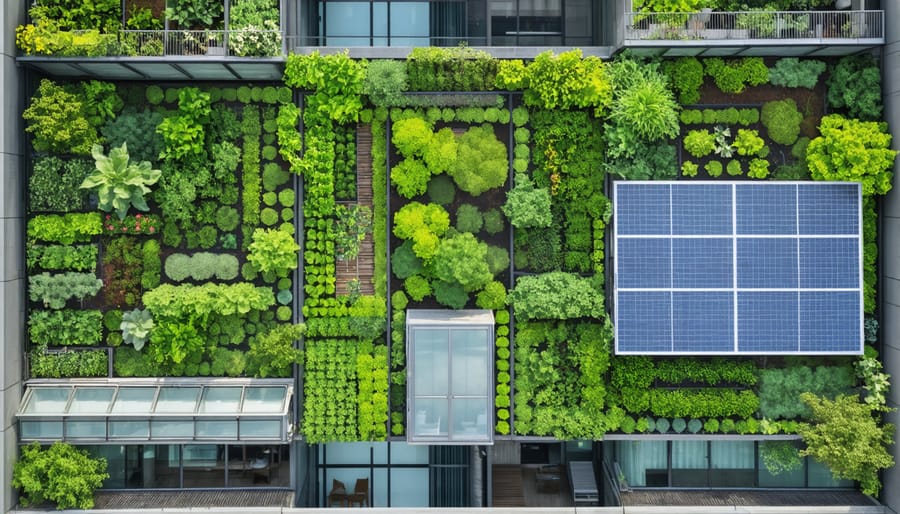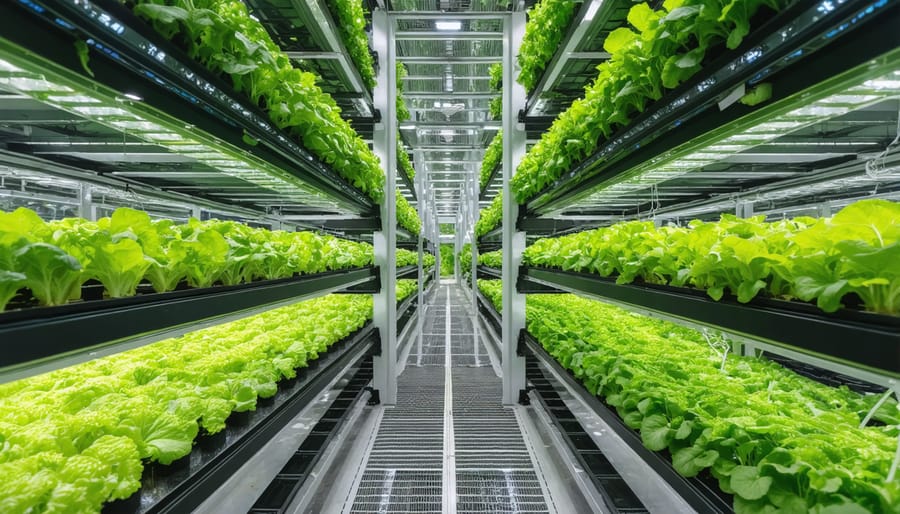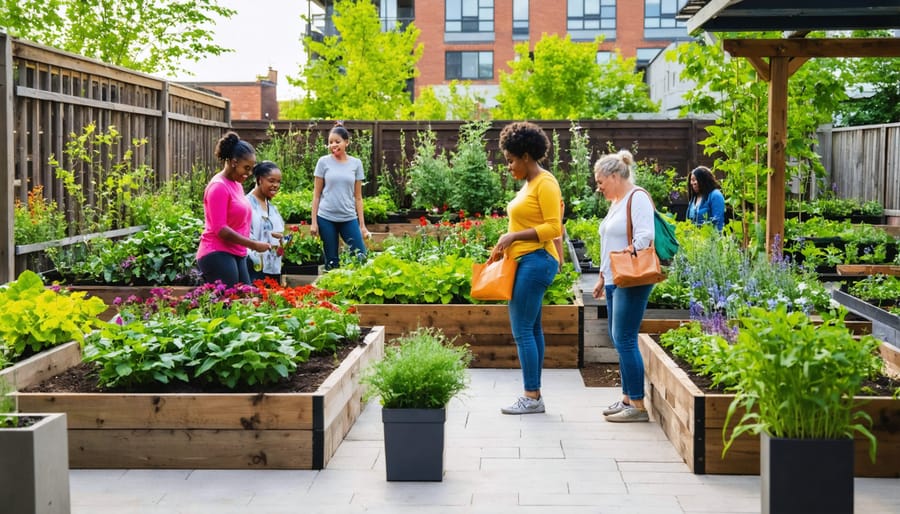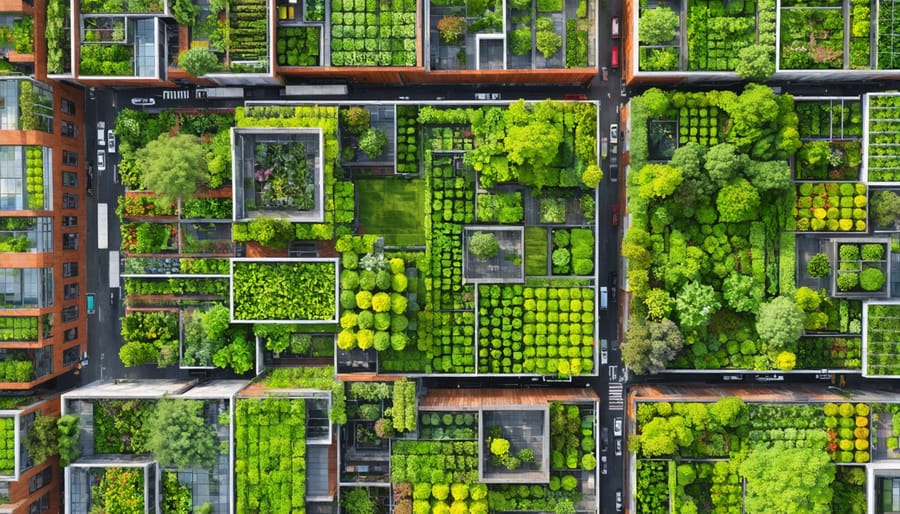Urban agriculture transforms underutilized spaces into productive agricultural hubs, revolutionizing how cities approach food security and urban green infrastructure. From vertical farming systems integrated into commercial buildings to rooftop greenhouses yielding year-round produce, these innovative agricultural solutions deliver tangible benefits for modern metropolitan areas.
Professional architects and developers now incorporate agricultural components into building specifications, recognizing their potential to reduce carbon footprints while generating significant ROI. Leading examples include Singapore’s Sky Greens vertical farm, producing one ton of vegetables daily, and New York’s Brooklyn Grange, operating 5.6 acres of rooftop farms across multiple commercial structures.
The technical implementation of urban agriculture demands precise engineering considerations: structural load capacity analysis, integrated irrigation systems, and specialized growing medium specifications. These systems routinely achieve 30% higher yield per square foot compared to traditional farming methods, while reducing water consumption by up to 90% through hydroponic and aeroponic technologies.
This evolving sector represents a crucial intersection of construction innovation, sustainable design, and urban food production, offering construction professionals unprecedented opportunities to reshape city landscapes while addressing critical food security challenges.

Rooftop Revolution: Building-Integrated Agriculture
Structural Engineering Challenges
Implementing rooftop agriculture presents unique structural challenges that require careful engineering consideration. The primary concern is weight loading capacity, as soil, plants, irrigation systems, and foot traffic can add significant stress to existing structures. Typical extensive green roof systems weigh between 60-150 kg/m², while intensive agricultural systems can exceed 300 kg/m².
Building modifications often necessitate reinforcement of load-bearing elements, including columns, beams, and foundation systems. Engineers must conduct thorough structural assessments to evaluate the building’s capacity to support additional dead loads (permanent installations) and live loads (temporary factors like maintenance personnel and equipment).
Waterproofing and drainage systems demand particular attention to prevent moisture damage to the building envelope. Multiple protective layers, including root barriers, drainage mats, and water retention membranes, must be properly integrated into the existing structure. Wind uplift forces at roof level also require careful consideration, especially for raised planting beds and vertical growing systems.
Recent innovations in lightweight growing media and modular planting systems have helped address these challenges. For example, hydroponic systems can reduce structural load requirements by up to 50% compared to traditional soil-based methods. Advanced composite materials and strategic placement of growing areas over load-bearing walls have also emerged as effective solutions.
Safety factors must account for seasonal variations in load distribution, particularly in regions with heavy snowfall or intense rainfall. Regular structural monitoring and maintenance protocols are essential to ensure long-term system integrity.
Integration with Green Building Systems
Urban agriculture initiatives are increasingly being integrated with sustainable building practices to create holistic eco-friendly developments. Modern building designs now incorporate dedicated spaces for agricultural production, from rooftop greenhouses to vertical farming systems integrated into building facades.
These integrations serve multiple functions: they improve building energy efficiency through natural insulation, manage stormwater runoff, and reduce the urban heat island effect. Advanced hydroponic and aeroponic systems are being incorporated into building mechanical systems, utilizing recycled water and waste heat from HVAC operations to support crop growth.
Leading architectural firms are developing innovative solutions that combine building automation systems with agricultural needs. Smart building management systems monitor and control growing conditions, including temperature, humidity, and lighting, while optimizing energy usage. These systems can be programmed to adjust growing conditions based on crop requirements and environmental factors.
The integration extends to waste management systems, where organic waste from buildings can be composted and used as fertilizer for urban farming operations. Building-integrated agriculture also contributes to LEED certification points and other green building standards, making it an attractive option for developers seeking sustainability certifications.
Recent case studies demonstrate that these integrated systems can reduce building operating costs by up to 23% while providing fresh produce for building occupants and local communities.
Vertical Farming: Maximizing Urban Space
Advanced Growing Technologies
Modern urban agriculture relies heavily on sophisticated growing technologies that maximize space utilization and crop yields while minimizing resource consumption. Hydroponic systems, which cultivate plants in nutrient-rich water solutions without soil, are increasingly popular in commercial urban farming operations. These systems typically incorporate precision monitoring equipment for pH levels, nutrient concentrations, and water quality.
Vertical farming infrastructure utilizes LED growing lights specifically calibrated for optimal plant growth, reducing energy consumption by up to 70% compared to traditional greenhouse lighting. Advanced climate control systems maintain ideal temperature and humidity levels through automated HVAC systems integrated with smart sensors and control panels.
Aeroponic systems, a more advanced variation of hydroponics, suspend plant roots in air-filled chambers where they receive periodic nutrient misting. This technique requires specialized high-pressure pumps and atomizing nozzles but can reduce water usage by up to 98% compared to conventional farming methods.
Building automation systems (BAS) play a crucial role in managing these technologies, integrating various subsystems including irrigation, lighting, and climate control. Modern facilities often incorporate IoT sensors for real-time monitoring and data analytics, enabling precise resource management and predictive maintenance.
For structural considerations, these systems typically require reinforced floor loading capacity (minimum 100 kg/m²), waterproof membranes, and specialized drainage systems. Electrical infrastructure must support significant power requirements, often necessitating dedicated transformers and backup power systems.

Energy Efficiency Solutions
Modern urban agriculture facilities are increasingly incorporating advanced energy efficiency solutions to optimize resource consumption and reduce operational costs. LED grow lights with automated control systems reduce electricity usage by up to 40% compared to traditional lighting methods, while smart HVAC systems maintain optimal growing conditions with minimal energy expenditure.
Passive solar design principles are being integrated into greenhouse structures, utilizing thermal mass materials and strategic orientation to regulate temperature naturally. Heat exchange systems capture and redistribute excess heat from growing areas to other facility zones, maximizing energy utilization. Combined heat and power (CHP) systems are becoming standard in larger operations, generating both electricity and thermal energy from a single fuel source.
Advanced building management systems (BMS) monitor and adjust energy consumption in real-time, responding to environmental conditions and crop requirements. These systems integrate with renewable energy sources, particularly solar panels and wind turbines, to create hybrid power solutions that ensure consistent energy supply while minimizing grid dependency.
Water-energy nexus considerations have led to the implementation of gravity-fed irrigation systems and energy-recovery devices in water treatment processes. These innovations, coupled with smart metering and predictive maintenance protocols, create highly efficient urban agricultural operations that serve as models for sustainable food production.

Community Garden Transformations
Design and Infrastructure
The successful implementation of urban agriculture projects requires careful consideration of both structural and environmental factors. Load-bearing capacity stands as a primary concern, particularly for rooftop installations where existing buildings must support additional weight from soil, water, equipment, and vegetation. Structural engineers typically recommend reinforcement systems capable of handling 100-150 pounds per square foot for intensive growing operations.
Building envelope integrity demands waterproofing membranes and root barriers to protect underlying structures. Modern green roof systems incorporate multiple layers, including drainage materials, filter fabrics, and growing media specifically engineered for urban agriculture applications. Irrigation infrastructure must be carefully integrated, often utilizing smart systems that optimize water usage through soil moisture sensors and weather-responsive controls.
Climate control poses unique challenges in urban settings. Vertical farming operations frequently require sophisticated HVAC systems to maintain optimal growing conditions. These systems must account for heat generated by artificial lighting and equipment while managing humidity levels to prevent mold growth. Energy-efficient designs incorporate passive ventilation where possible, supplemented by mechanical systems during peak demand periods.
Access considerations are crucial for maintenance and harvesting. Design elements should include service elevators or hoists for material transport, adequate workspace for equipment operation, and clear pathways meeting occupational safety standards. Integration of storage areas for tools, supplies, and harvested produce must be planned during the initial design phase.
Lighting systems, particularly in indoor growing environments, require careful specification of PAR (Photosynthetically Active Radiation) values and installation of appropriate electrical infrastructure. Modern LED growing systems typically demand 20-40 watts per square foot, necessitating robust electrical systems with consideration for future expansion capabilities.
Community Engagement Strategies
Successful urban agriculture projects depend heavily on effective community engagement strategies that foster long-term participation and sustainable operations. Project developers must implement structured approaches to involve local stakeholders from the initial planning phases through ongoing maintenance.
Key engagement methods include establishing community advisory boards comprising local residents, business owners, and agricultural experts. These boards help shape project objectives, design parameters, and operational guidelines while ensuring alignment with community needs. Regular workshops and training sessions equip participants with essential knowledge in urban farming techniques, sustainable practices, and project management.
Professional construction teams should collaborate with local organizations to create mentorship programs, connecting experienced urban farmers with newcomers. This knowledge transfer system helps maintain consistent operational standards and promotes community ownership of the projects.
Digital platforms and mobile applications can streamline communication and coordination among stakeholders. These tools facilitate resource sharing, maintenance scheduling, and harvest distribution, while providing real-time updates on project progress and community impact metrics.
To ensure long-term sustainability, implementing tiered participation models allows community members to engage at various commitment levels. This flexibility accommodates different schedules and capabilities while maintaining consistent project operations. Additionally, establishing partnerships with local educational institutions creates opportunities for research, innovation, and workforce development in urban agriculture.
Regular monitoring and evaluation of engagement levels, coupled with adaptive management strategies, help identify and address participation challenges early. This data-driven approach enables project managers to optimize community involvement and ensure the long-term success of urban agriculture initiatives.
Future-Proofing Urban Agriculture
The landscape of urban agriculture is rapidly evolving, with technological innovations and sustainable practices reshaping how we conceptualize food production in cities. Smart farming systems, incorporating IoT sensors and automated climate control, are becoming standard features in modern urban farming facilities. These systems optimize resource usage by monitoring soil moisture, nutrient levels, and environmental conditions in real-time, enabling precise control over growing conditions.
Vertical farming technology continues to advance, with new hydroponic and aeroponic systems achieving higher yields in smaller footprints. Leading construction firms are now integrating these systems into building designs, creating multi-story farming operations that maximize limited urban space while minimizing water consumption by up to 95% compared to traditional farming methods.
Renewable energy integration is becoming crucial for sustainable urban agriculture operations. Solar panels and wind turbines are being incorporated into greenhouse designs, creating energy-independent growing environments. Advanced building materials, such as smart glass and phase-change materials, are being employed to regulate temperature and light transmission more effectively.
AI and machine learning applications are revolutionizing crop management and yield prediction. These technologies analyze data from multiple sources to optimize growing conditions and predict maintenance needs, reducing operational costs and increasing productivity. Some facilities report productivity increases of up to 40% after implementing AI-driven systems.
Urban agriculture is also embracing circular economy principles. Waste-to-resource systems are being developed, where organic waste from restaurants and households is converted into compost and biogas, powering urban farming operations. Advanced water recycling systems are being implemented, capturing and treating greywater for irrigation use.
Looking ahead, emerging technologies like CRISPR gene editing and microbiome engineering could further enhance crop resilience and nutritional value. The integration of robotics for harvesting and maintenance tasks is expected to reduce labor costs and increase operational efficiency. These advancements, combined with sustainable building practices, are creating a robust foundation for the future of urban agriculture.
Urban agriculture has emerged as a transformative force in modern construction and urban development, demonstrating remarkable potential for sustainable city growth. Through the examples explored in this article, we’ve seen how innovative architectural solutions, from rooftop greenhouses to vertical farming systems, are reshaping our urban landscape while addressing critical food security challenges.
The success of implemented projects worldwide proves that urban agriculture is more than just a trend—it’s becoming an essential component of resilient city planning. The integration of agricultural spaces into buildings has shown significant benefits, including reduced carbon footprints, improved building energy efficiency, and enhanced community engagement.
Looking ahead, the future of urban agriculture appears promising, with advancing technologies and growing environmental awareness driving innovation. We can expect to see more sophisticated hydroponic systems, automated farming solutions, and better integration of agricultural spaces into new construction projects. The construction industry will play a pivotal role in this evolution, developing new materials and methods specifically designed for urban farming applications.
For construction professionals and urban planners, the key takeaway is clear: urban agriculture represents a significant opportunity to create more sustainable, resilient, and livable cities. As regulations evolve and market demand increases, incorporating agricultural elements into building designs will likely become standard practice rather than an exception. Success in this field will require continued collaboration between architects, engineers, and agricultural experts to develop solutions that are both practical and economically viable.

